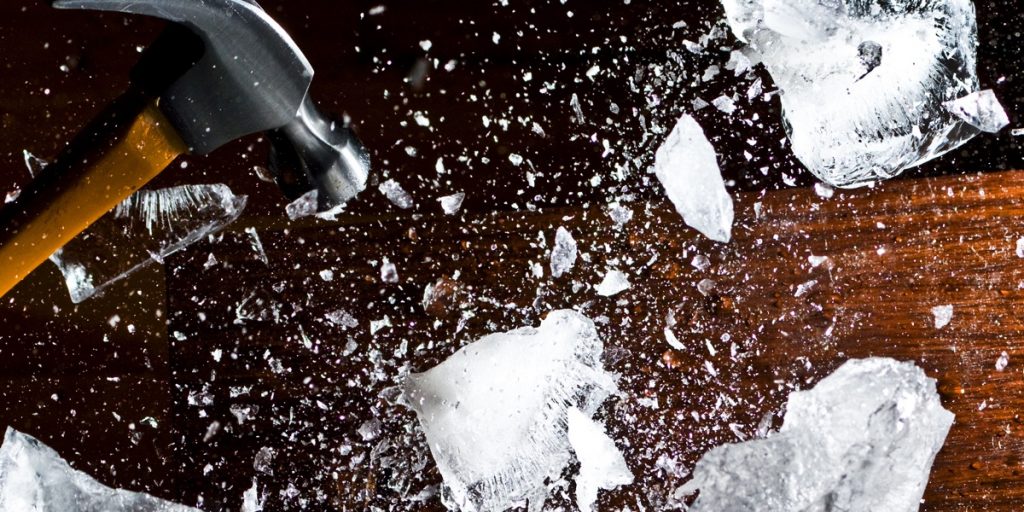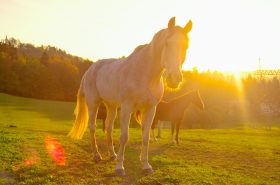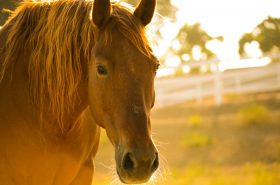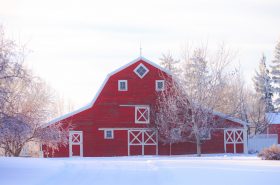Snow covered fields. The warm breath of your horse against your cold face. A quiet stillness in the barns. Every. Single. Water. Bucket. Frozen. Winter is as frustrating as it is beautiful.
Just like the majority of horse owners, I fancy myself a do-it-yourself type, a tough it out type, and a scrimp on the necessities to splurge on the extras type. Nowhere was this more apparent and more misguided than my tales of winter water woes. Consider this more of a do not try this at home list, than a how-to blog. I have tried everything and it is finally time to admit I need to install an automatic waterer that doesn’t freeze (such as the Drinking Post Waterer from RAMM Horse Fence). If you’re still on the fence about skipping those few extra show fees or horse camping trips to save up for a boring infrastructure improvement like a year-round waterer, let me tell you what not to do in the meantime.
Frozen frost-proof yard hydrants.
The hydrant works by using positive pressure to displace any water that is in the above ground pipe into an overflow below the frost line to drain when the handle is pushed down. This drains the hydrant and prevents it from freezing, but the spigot of the hydrant often leaks water out of worn seals. This water then freezes, freezing the handle of your hydrant stuck. One trick to overcome this is to flip a bucket of straw over the hydrant handle. I couldn’t figure out how to keep the straw in an upside-down bucket. The straw only adds a few degrees of protection and it will still freeze on those extra bitter cold days. Hair dryers are another common solution. If you can thaw the ice in the handle, the rest of the yard hydrant should work just fine. Coming from a farm family that frequently used hair dryers to start old tractors, you better have several back up hair dryers. Hair dryers were not designed with this job in mind and don’t like these sorts of activities. Used for thawing, their useful life is limited.
The old floating milk jug.
We’ve all heard the old wives tale of the milk jug filled with salt water. The theory behind this one is that salt water is less dense than water and so the jug floats. If the wind blows or the horses move the jug around it helps to disrupt the ice crystal formation in the tank. If the tank does freeze, then the horses can push the jug down to get to the water below. This sort of worked on the light freezes, mid 20’s to 30’s. However, the horses have pretty strong muzzles and were breaking through light ice layers on their own on the opposite side of the tank from the jug. The winds are enough to move the water on their own without a jug. This might provide some help in milder climates but when the entire tank froze, my little saltwater milk jug just froze dead in the middle of it and was actually a bigger hindrance trying to break ice out.
 Breaking ice and breaking water tanks.
Breaking ice and breaking water tanks.
Ground water is about 50oF. That means if your horses are drinking a lot and you’re refilling tanks regularly, they won’t freeze completely solid. Thanks to convection and conduction they will start to freeze on the exposed surface and sides but not in the middle. We can just whack through that top ice with a sharp object right? Oh I whacked through that ice clear through to a hole in the bottom of my tank. A fiberglass resin repair kit can fix this little oopsy in no time but it does shorten the life of your poly-tank.
Water + Electricity = Danger?
We’re told over and over that electricity in or near water is dangerous but the first solution we all run to during a cold winter is electricity in water. When all instructions of a tank heater or de-icer are followed, they are safe. But who actually follows all the instructions? I definitely broke several. I plugged my floating de-icer into a standard house outlet, not a dedicated circuit. I plugged my de-icer into an extension cord. Come on now, if I had a dedicated outlet right next to the tank, I’d probably already have a year-round water tank wouldn’t I? I did use my de-icer in the appropriate style of tank, poly tank, not metal. I tried not to get the plug wet by draping it over the fence before leaving on vacation for the weekend because the forecast called for freezing rain. Oh right, you’re not supposed to leave them unattended either. Well guess what? Water + Electricity = Danger. My de-icer got hung up on the fence where I was trying to keep the plug out of the rain and didn’t fall with the water level. Instead it swung over and melted a giant hole all the way down the side of my poly tank. It also didn’t trip the circuit breaker because it was plugged in to an extension cord. It just kept sizzling and melting the tank until I came home to a wrecked poly tank and two very freaked out horses.
Sunny stories of solar water tanks
Next I decided that solar was safe and free! I researched plans for DIY solar stock tanks. Most of these involve heavy construction with the tank permanently installed in a black plywood box and spray insulated. That is great in a Midwest winter but in a hot, humid Midwest summer that tank will be ripe for algae growth and impossible to clean. That would mean I’d have to keep this bulky tank around all year for just 2 months of use. I decided to try to outsmart the internet. Don’t. You can’t outsmart the internet. They make houses out of straw because it is such a good insulator. I had some spare fiberglass insulation and the wrecked poly tank. Two tanks have to insulate better than one! I filled the broken tank with insulation and then nested the good tank inside. I built a straw house around my water tank and secured it with ratchet straps. I cut a foam insulation board to fit in the top of the tank and then put a half sheet of plywood over the top to cut down on surface area of the water. I put the whole contraption on the South side of the barn up against the wall to try to further cut the wind and catch the sun. It froze solid by the end of the week. Then, my horse ate the straw I was using as insulation.
Winter workouts
After all of these adventures, I ended up bucketing water from my house from my spare shower twice a day for the horses. Water weighs 8.3 lbs/gallon. My two horses were drinking 20-30 gallons a day, 166 to 249 pounds. Whew! And I only had to go 20 feet to the fence, only have two horses, and I only flooded the bathroom twice all winter. This simply isn’t practical for most horse owners.
Winter water wonders
There are still some crazy winter water ideas out there I haven’t tried, recirculating pumps to keep water moving or improved DIY solar horse tanks, but I think I’ve tried enough to know that saving for and installing a year-round watering system is well worth the effort.
**Lynn Doran is an outdoor enthusiast, avid Appaloosa fan, and weekend trail explorer. She calls Illinois home and aims to show the best the state has to offer equestrians through her Complete Illinois Get Out and Ride Horse Guide, Trottingspots.com.



